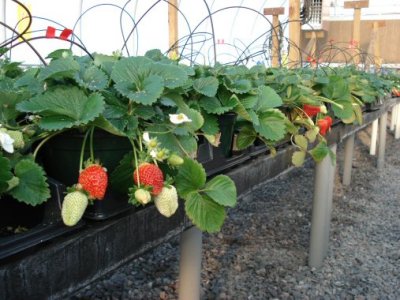What's New? UT Strawberry Project — variety, spacing trial

Evaluation of Cultivars and Plug Establishment Date on Greenhouse Strawberry Production, 2006-2007
Procedure:
Experiment 1. Runner tips were collected from five strawberry cultivars (‘Camarosa’, ‘Carmine’, ‘Chandler’ and ‘Ventana’ (short-day strawberries), and ‘Evie-2’ (everbearing strawberry) in early July and in early August. Runner tips were also collected from ‘Raritan’, ‘Noreaster’ and ‘Darselect’ in July and also established as plug plants. In mid September, the plug plants were transferred to 6 inch x 4.5 inch round pots containing 50% Promix and 50% perlite. An experiment was established with the 13 randomized treatments and eight replications in a heated 96 ft by 30 ft polyethylene-covered greenhouse at the East Tennessee Research and Education Center, Knoxville. The pots were placed on greenhouse benches in trays that kept pots spaced 12 inch (center-to-center) within-row and in double rows 6 inches apart. In mid October, plug plants of ‘Sweet Charlie’ and ‘Strawberry Festival’ were purchased and planted in pots in the planned locations in the experiment. Plants were fertigated with nutrient solutions containing Hydro-Gardens strawberry formula 8-12-32, magnesium sulfate and calcium nitrate.
The greenhouse was treated twice with insect bombs prior to planting. During the trial, insects and mites were controlled with the following biologicals: the predatory mite Phytoseiulus persimilis to control two spotted mites, the predator mite Neoseiulus cucumberis to control thrips and the parasitic wasps Encarsia formosa and Eretmocerus eremicus to control white flies. Bumblebees were used for pollination. Yield data was collected and observations made from establishment until mid April.
Experiment 2. Plug plants of ‘Carmine’, ‘Camarosa’, ‘Chandler’ and ‘Sweet Charlie’ were purchased and established in 6 inch x 4.5 inch round pots pots in mid-October. An experiment was established in the above greenhouse with the four cultivars with 6 or 12 inches (center-to-center) in-row spacing in double rows 6 inches apart.
Results:
Experiment 1. The first harvest was collected on 13 November and harvest continued until 13 April.
- For the November-December period, ‘Carmine’ (July tip-cutting) had the highest yield (0.5 lb/plant). Plants from July tip cuttings of ‘Camarosa’, ‘Evie-2’, and ‘Ventana’ had approximately 0.4 lb/plant). Yields of ‘Raritan’, ‘Noreaster’, and ‘Darselect’ were less than 0.2 lb/plant. Yields of the five cultivars propagated in July had approximately 35 percent more yield than the same cultivars propagated in August. An initial delay of supplying pollinators and inadequate regulation of daytime high temperatures probably reduced yields during the November-December period.
- For the entire harvest period, ‘Evie-2’, ‘Carmine’, and ‘Camarosa’ yielded approximately 2 lb/plant. Fruit of ‘Evie-2’ were relatively large but had poor flavor, and ripened unevenly. ‘Carmine’ and ‘Camarosa’ had acceptable flavor and fruit size. ‘Ventana’ plants yielded slightly less fruit but had the best fruit quality throughout the trial. ‘Raritan’, ‘Noreaster’, and ‘Darselect’ yielded less than 1 lb/plant and had the smallest berries and less desirable fruit quality. ‘Strawberry Festival’ fruit were flavorful and relatively large fruit and yielded 55% more than ‘Sweet Charlie’. ‘Sweet Charlie’ plants seemed to have more pollination problems and suffered much more wilt late in the season than other cultivars. Again, a delay in supplying adequate numbers of pollinators at various times probably reduced overall yields.
- The two-spotted mite was the most common and difficult pest to control, but initial high populations of P. persimilis eventually controlled the pest. P. persimilis populations were released at least every two weeks to control mites. Minor outbreaks of whiteflies were controlled with the parasitic wasps.
Experiment 2:
- ‘Camarosa’, ‘Chandler’ and ‘Sweet Charlie’ plants yielded less than 55% as much fruit/plant at the 6 inch in-row-spacing as plants grown at the 12 inch spacing during November and December harvest period.
- Only ‘Carmine’ had relatively high yields at the 6 inch spacing (89% yield of plants at the 12 inch spacing), thus may be better adapted for higher planting densities in a greenhouse.
- ‘Sweet Charlie’ plants had very low yields compared to ‘Camarosa’, ‘Carmine’ and ‘Chandler’.
Conclusions:
- July tip-cutting plug plants yielded more than those started in August.
- Our trial showed that yields of 0.5 lb/plant by 1 Jan. and 2.0 lb/plant by mid April could be achieved in the greenhouse even though several factors limited production.
- ‘Carmine’ and ‘Camarosa’ yielded 1.9 lb/plant and had acceptable fruit quality. ‘Ventana’ yielded approximately 1.7 lb/plant with the highest quality fruit.
- Several cultivars were deemed unacceptable because of low yields or fruit size (‘Raritan’, ‘Noreaster’, and ‘Darselect’) or for poor fruit quality (‘Evie-2’).
The insect and mite pests were almost entirely controlled with biologicals, thus demonstrating that strawberries can be produced with little or no need for insecticides/miticides. Bumblebees can be used to pollinate strawberries throughout the winter. Their use necessitates the concern for pesticides. A major part of the costs of using predators for insect/mite control in a single greenhouse was the shipping costs. Growers may need to grow greenhouse strawberries on a larger production scale, join with other growers to share shipping costs or find ways to keep predators reproducing in the houses in order to improve the economics of using biologicals for control and pollination.

